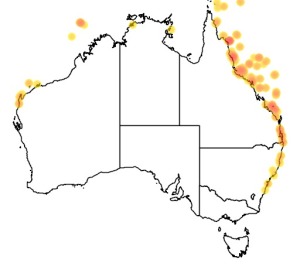Colours
Distinguishing features
Body colour varies from pale blue/grey to brown. Yellowish pectoral fins and a yellowish band through the eye are distinctive. Often a white ring around the tail base but not always. Tail spines dark.
Size
- Up to 58 cm (Length of specimen)
Depth range
- Depth range data is not yet available.
Synonyms
Comments
Allen et al (2003) note that this is the largest surgeonfish, growing to 58 cm.
by Anne Hoggett
Distribution
Distribution and habitat preferences
Areas of turf algae and coral rubble on sheltered lagoonal reef flats and slopes, and sandy substrata close to reef edges.
Found in most reef habitats around the island, usually near areas of sand along reef margins.
Behaviour
The Yellowmask Surgeonfish is a roving detritivore, moving around the reef usually singly or in small groups, and feeding on the organic detritus that accumulates on sandy and turf algal covered substrata. The surgeonfish are a very long lived group of fishes - after settlement to the reef, juveniles grow quickly and reach 80% of their maximum size in about 3 years, and then grow very slowly thereafter. Many of them live from 30-50years. They spawn in groups during the warmer months, when fast running tidal currents coincide with dawn and dusk.
Web resources
Danger
- unspecified - There are a pair of poisonous bony knives at the base of the tail, which can be used to inflict a painful stabbing wound if the fish is handled.
References
References that assist with identification
- Allen, G., R. Steene, P. Humann and N. Deloach (2003). Reef fish identification: Tropical Pacific New World Publications Inc., Jacksonville, FL, USA.
Other references
- Choat, J.H. and L.M. Axe (1996). Growth and longevity in acanthurid fishes; an analysis of otolith increments, Marine Ecology Progress Series, 134: 15-26. LIRS catalog number 460.
- Clements, K.D. (1991). Gut microorganisms of surgeonfishes (Family Acanthuridae), Ph.D. thesis, James Cook University, Townsville. LIRS catalog number 321.
- View all references





